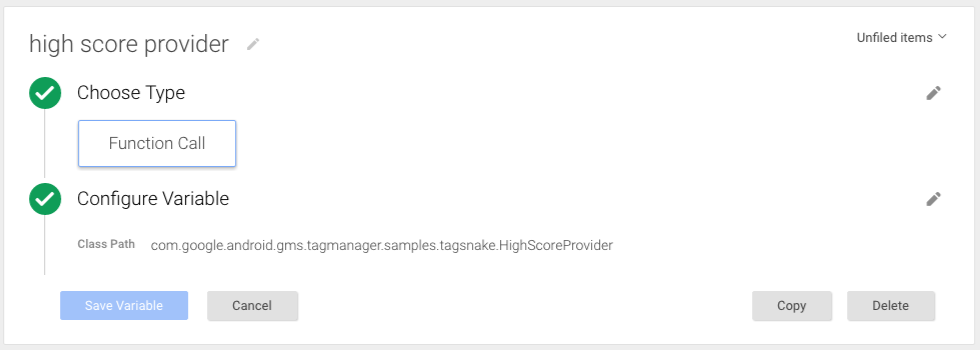Để mở rộng chức năng của Trình quản lý thẻ của Google, bạn có thể thêm biến Lệnh gọi hàm và thẻ Lệnh gọi hàm. Biến Lệnh gọi hàm cho phép bạn ghi lại các giá trị được trả về bằng lệnh gọi đến các hàm được đăng ký trước. Thẻ Lệnh gọi hàm cho phép bạn thực thi các hàm đã đăng ký trước (ví dụ: để kích hoạt lượt truy cập cho các công cụ đo lường và tái tiếp thị bổ sung hiện không được hỗ trợ bằng mẫu thẻ trong Trình quản lý thẻ).
Thêm thẻ và biến tuỳ chỉnh
Cách thêm thẻ tuỳ chỉnh hoặc biến tuỳ chỉnh bằng Lệnh gọi hàm:
Triển khai một lớp giúp mở rộng
com.google.android.gms.tagmanager.CustomTagProviderhoặccom.google.android.gms.tagmanager.CustomVariableProvider:import android.support.annotation.Keep; import java.util.Map; @Keep public class HighScoreProvider implements com.google.android.gms.tagmanager.CustomVariableProvider { @Override public String getValue(Map<String, Object> map) { synchronized (HighScoreProvider.class) { return ((Long)sHighScore).toString(); } } private static long sHighScore = 0; public static void recordScore(long score) { synchronized (HighScoreProvider.class) { sHighScore = Math.max(score, sHighScore); } } }Nếu bạn sử dụng ProGuard, hãy đảm bảo rằng tên và phương thức của lớp không bị làm rối mã nguồn. Hãy sử dụng chú giải Keep để chỉ định điều này.
Trong giao diện web của Trình quản lý thẻ của Google, hãy sử dụng tên lớp đủ điều kiện để thiết lập thẻ và biến:

